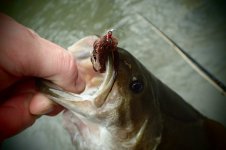
By Maurice
While sharing some time on the water the other day with Dave Kile (dkile) I experienced what seems to happen often during a decent hatch with some wind, you guessed it, a wind knot! Or as Lefty Kreh calls them, bad casting knots. Everyone gets them now and then, especially when combining a breeze, long leaders and fine tippets. Or for the chuck and duck crowd, of which I am often a member, weight and multiple flies. So as Dave stands upstream pondering my delay to cast to a rising fish, he asks, what’s the problem Einstein? I said I have a wind knot, and it reminded me of a tip I learned many years ago.
Back in the 80’s we were on a bus trip to the Breeches from the ‘burg and there was a video on the tube for those not taking the time to sleep. Being full of interest in sponging any and all info I could at the time, one tip in the video stuck with me. Terminal knot tying efficiency. Think about it, every time we tie on a new piece of tippet, a new fly, etc., we are out of the game. It stands to reason that the faster you can tie on a fly (improved clinch knot in my case) or a new piece of tippet (surgeons knot), the quicker you can begin flogging the water again.
The video stressed the need to get your knots down to 15 seconds each. Practice, practice, practice until you can meet that goal. This will put your fly change or tippet adjustments into under one minute if you include the spooling off tippet, picking out a new and returning the old flies. If you find yourself taking 5-10 minutes each to accomplish that task, you could likely be wasting an hour or more tying frustrating knots. Practicing on stream is KNOT efficient! (pun intended)Now it’s not a race, and I don’t suggest it to be. But it is practical to be as efficient as possible when enjoying your streamside time. Plus, when a hatch is on, the fish and bugs don’t wait until you re-tie, it goes on as scheduled, often it seems to go faster as the trouts plop, plop, plop all around you.
So do yourself a favor by following these few tips;
• Get your knots down to 15 seconds or so.
• Accept the fact your eyes are going bad and get some readers if seeing the eye is getting harder every year.
• Keep your tippet handy, I keep mine outside near my left hip where I can reach it easily.
• Keep your flys handy with few boxes so searching is not too long.
• Know your limitations and adapt.

Lastly, If it's a total mess clip it ALL off and start over, in one minute or so you will be casting again.
Now I consider myself a pretty good untangler…in fact, my slogan is “Fly fishing is the art of tangling and untangling lines of different diameters while trying to enjoy yourself”. But it doesn’t have to be yours.
Last edited by a moderator:




